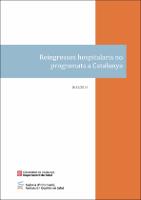| dc.contributor | Departament de Salut |
| dc.contributor.author | López-Aguilà, Sílvia |
| dc.contributor.author | Rajmil, Luis |
| dc.date.accessioned | 2017-11-03T10:07:02Z |
| dc.date.available | 2017-11-03T10:07:02Z |
| dc.date.issued | 2011-11 |
| dc.identifier.citation | López-Aguilà S, Rajmil L. Reingressos hospitalaris no programats a Catalunya. Barcelona: Agència d’Informació, Avaluació i Qualitat en Salut; 2011. |
| dc.identifier.other | IN12/2011 |
| dc.identifier.uri | https://hdl.handle.net/11351/3123 |
| dc.description | Risk factors; Unscheduled hospital readmission; Catalonia |
| dc.description.abstract | Objectives: to study the risk factors and the likelihood of unexpected hospital readmissions in Catalonia during 2007.
Methodology: this is a retrospective cohort study in population over 14 years of age admitted to hospitals of the public hospital network (PHN). The dependent variable was the emergency readmission at 6 months. First emergency admission or index admission was considered all emergency admissions occurred between 01/01/07 and 31/12/07; and emergency readmission were all readmissions occurred in the 6 months following index admission. The independent variables were: sociodemographic (gender, age and health region), morbidity (number of concurrent diagnoses, diabetes, ischemic heart disease, chronic obstructive pulmonary disease (COPD), asthma, emphysema, bronchiectasis, and heart failure) and use of hospital services during two years before index admission (emergency and programmed admissions, and programmed emergency and scheduled stay). Logistic regression models were adjusted to study factors associated with readmission.
Results: of the 195729 persons urgently admitted in 2007, 19.5% was readmitted during the next
6 moths. Factors associated with readmission were being a male, having ≥65, having ≥5 concurrent diagnoses, heart failure, COPD, diabetes and ≥2 emergency admissions in 2006 or 2005. The factors with strongest association were having ≥5 concurrent diagnoses (OR = 4.37, 95% CI = 4.23 to 4.52), having heart failure (2.89, 2.78 to 3.01) and COPD (2.76, 2.63 to 2.90). The area under the Receiver Operating Characteristic curve (ROC) was 0.74.
Conclusions: the predictive model allows the identification of patients at risk of hospital readmission and may represent an annual reduction of 27,302 (3%) hospital discharge. |
| dc.language.iso | cat |
| dc.publisher | Agència d’Informació, Avaluació i Qualitat en Salut |
| dc.rights | Atribución-NoComercial-SinDerivadas 3.0 España |
| dc.rights.uri | http://creativecommons.org/licenses/by-nc-nd/3.0/es/ |
| dc.source | Scientia |
| dc.subject | Hospitals - Ingressos i altes |
| dc.subject.mesh | Patient Readmission |
| dc.subject.mesh | Catalonia |
| dc.title | Reingressos hospitalaris no programats a Catalunya |
| dc.type | info:eu-repo/semantics/report |
| dc.identifier.dl | B. 41717-2011 |
| dc.subject.decs | Cataluña |
| dc.subject.decs | reingreso de pacientes |
| dc.type.version | info:eu-repo/semantics/publishedVersion |
| dc.audience | Professionals |
| dc.contributor.authoraffiliation | [López-Aguilà S, Rajmil L] CIBER en Epidemiologia i Salut Pública (CIBERESP), Madrid, Spain |
| dc.rights.accessrights | info:eu-repo/semantics/openAccess |

